There was always so much to see from the backseat of my parents’ automobile. I particularly loved the long, seemingly, tangled journey from Benson to any fine restaurant downtown and back again in the black of night. Like a tour of the exotic world, Downtown Omaha at night seemed peppered with all sorts of flamboyant characters from faraway, novel places. Or like a well-constructed set of an old movie, not yet abandoned. Any curious child from any backseat could have seen what was really going on. It was an open theater door to the adult world. The real stars had left the set but the second string extras were still milling about smoking, waiting for that day’s pay. I would listen intently to my parents or my grandparents as they explained while driving what had been a once flourishing department store, what restaurant it would later become and the what happened next when business moved west, trying to put the architectural puzzle together in my mind. They really were very good about answering my questions. And I don’t know why I cared, honestly, but I am so glad I did, for a lot of my friends were happy to be playing tic-tac-toe with their brother on the windows of their family car while traveling through town. I suppose that had its benefits as well.
A favored stretch of the drive home was along Farnam Street, from 24th to 28th Streets. If you have read my articles for a while, you surely have picked up on my obsession for this strip of our city. Check out Mysteries of Omaha: 2561 Douglas Street for more details on the Park East Neighborhood. You see, it all began with my dying interest in the colorful, ever so playful marquee of the Muse Theater on 24th and Farnam. Father of Miss Cassette would later explain that this was an adult movie house and that the films shown were of a risqué nature. Mind you, the wording was altogether different, more of a 1970s father-to-daughter type of explanation–with Mother of Miss Cassette listening, to be sure. I am convinced what followed must have been something of a parochial school girl Nancy Drew interrogation on my part. I must have put them both through the wringer. (Many years later my father would tell me about his college year exploits at the Muse–one time even taking a couple of sweet, unsuspecting nursing students for an “artful film” as a double date with his pal. The young nurses were not moved and properly retreated to their bus stop.) But back to the 1970s, I just couldn’t understand why all of those men appeared to be ducking into that fascinating place alone. In memory some of the loners were in those light tan London Fog trench coats, popular at the time. Other men were scattered about in the shadows next-door, smoking. I might be making that part up. I cannot be sure.

Honestly, there were many signs to stare at in those days! Signs at Pussy Cat Theater I and II – 1316 Douglas Street. Omaha Sun. 1972.

This is not the Muse Theater. This is a photo from the 1970s Bowery, NYC. Only used to illustrate my perception of the time.
A little bit further west on Farnam, I would crane my neck every time to get a peek at the beautiful, mysterious ladies of the night and the sprinkling of young, pretty boys holed up in the Smoke Pit on a much needed break. As a teenager, I would later assume that this slinky bevy of characters kept Cosmo’s Wigs in business all those years. The most I could hope for on those family drives along Farnam was to see a group of prostitutes walking assuredly in front of, now, All Makes and Barnhart Press, on their way to the Chosen Posts of either 25th or 26th Avenues where they would stand, smoke and further discuss pressing matters. Oddly, and yet divinely, positioned right along side of Kountze Memorial Lutheran Church where the fantastic lighting really backlit the whole thrilling scene. Let me gently interject that I lived a quite sheltered life on a quiet Benson street, so this was true theater to my eyes. Like a company parade of leopard, fishnets, garter belts, Cleopatra wigs and heels… those heels that I have not seen since. And the big cars, yes, the other cars circling the blocks, stopping, rolling down windows, negotiating, assessing. These were not other families circling the blocks. All single men. Fascinating to me. And the police cars that would roll on through the whole tempestuous tangle, right out in the open. It is weird what stays in the mind.
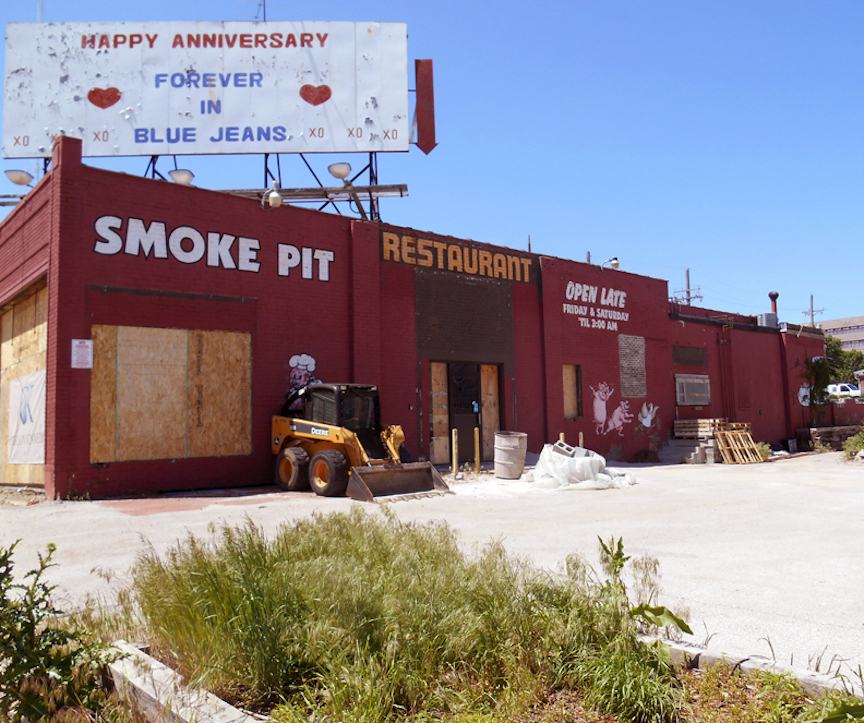
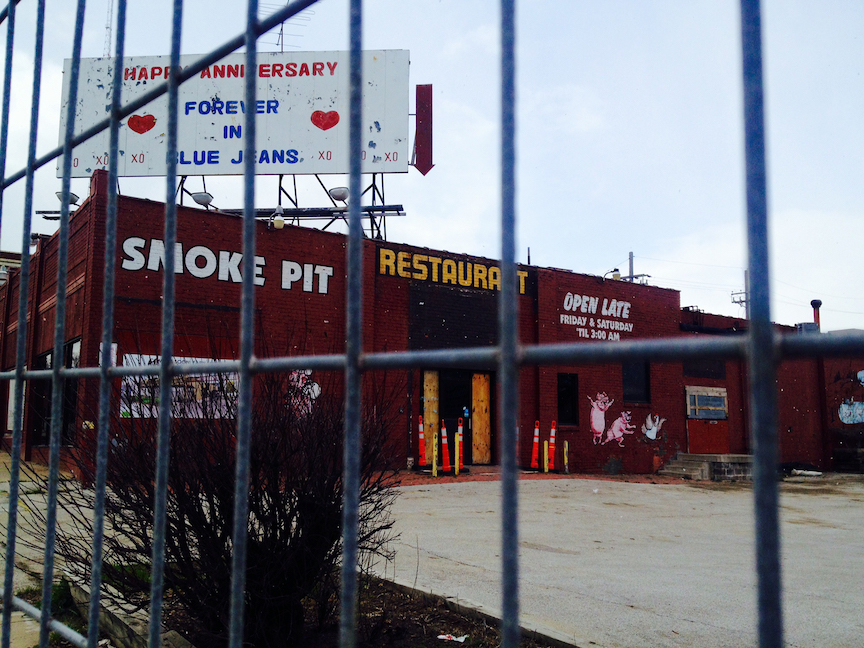
I captured these ones in the last days of the Smoke Pit. 230 South 25th Street.
As much as the Park East neighborhood drama had secured a peculiar interest in my early life, I lost track of the Muse Theater after leaving Omaha. I was surprised to find she had vanished long ago, unbeknownst to me, when I remembered my fascination with the harlequin strip. For all of my adventurous times spent at the Hamilton Apartments on 24th and Harney, early explorations into the perilous Delmar Hotel, my frequent visits to a little thrift store at about 222 S. 24th Street, concerts at the F.O.E. Hall and chance encounters at the mucky little diner, then called the Steak N Egg, at the Econo Lodge in the 1980s, I never as much as walked across the sidewalk in front of the Muse Theater. Why? When I began My Omaha Obsession last March (2016), the history and whereabouts of the Muse Theater was one of the top mysteries I wanted to investigate. Since then I have been actively engrossed with other cases, as you might have detected. But I am now ready to get back to my old obsession, the Muse Theater. Her tale, not unlike the truly brave among us, is filled with glory, earthiness and heartbreak.


I took these photographs years ago. I am not sure when. The empty space at 2405 Farnam Streetwhere the Muse Theater once glowed.
Part One
In the years previous to the Muse Theater being built, the only buildings that could be located near this corner in the Kellogg Place Addition were the “Old” Hamilton Apartments at 2402 Farnam, the “Old” Hamilton Café, carrying the same address and oddly, the “New” Hamilton Apartments and the “New” Hamilton Café at 2404 Farnam. I am not making this up, for this is a direct copy from the Omaha City Directory of 1913. Those addresses would all change over time. I will be writing about this whole animated Hamilton Hotel Apartments operation in the future, as that is quite the story in and of itself but for the time being, let me explain just a very few things. The Hamilton was a residential hotel that ran parallel to Harney Street. It had its own café. Later an additional Hamilton residential hotel was created, running parallel to 25th Street. It also had a café. There was a large park like courtyard in the middle of this L shaped operation. It must have been beautiful little spot at one time.
Friends, I finally that completed that Hamilton Hotel Apartments investigation and here it is: For the Love of 2406 Farnam Street.
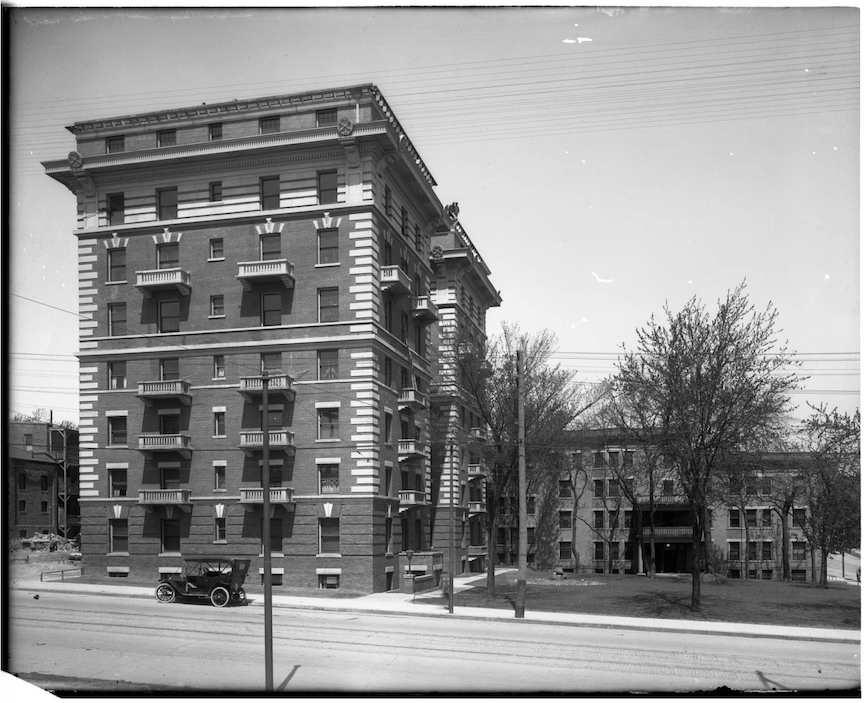
1910. The Hamilton Hotel Apartment–a residential hotel, not unlike the Colonial Hotel on 38th and Farnam. Check out the Brothers Lounge and the Case of the Vanishing Mom and Pop article for more on the Colonial Hotel. The taller of the two buildings was later razed. The smaller of the buildings remains to this very day. This photo faces north across from Farnam Street. (Photo courtesy of the Bostwick-Frohardt/KM3TV Photography Collection at The Durham Museum Photo Archive).
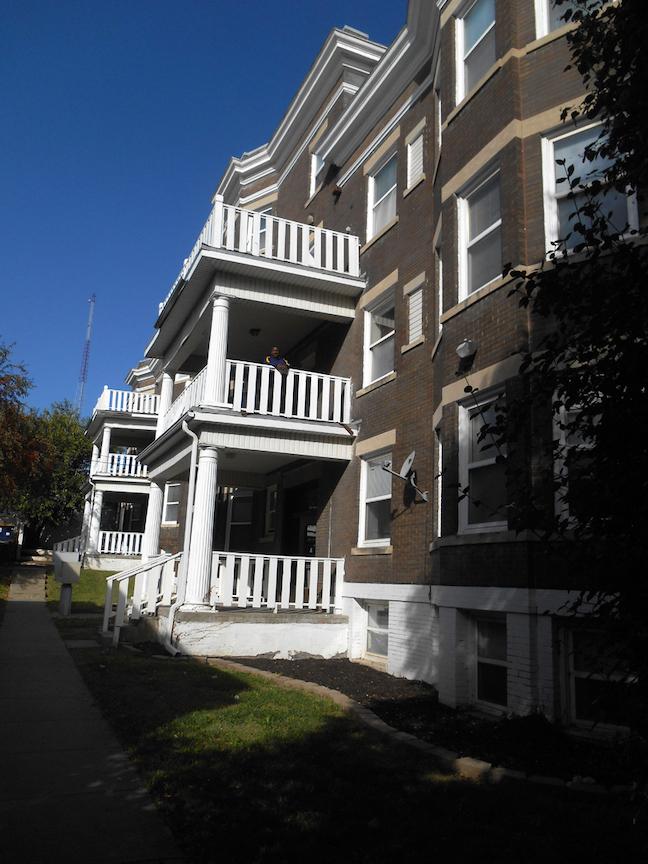
Here is the smaller of the Hamilton Hotel Apartments as it stands today. Because it once faced the courtyard and a one story retail building later filled in the whole courtyard, the Hamilton Hotel Apartments are now forced to face a brick wall. It is all very shameful. They now go by the address of 210 S. 24th Street and are called the Hamilton Garden Apartments.
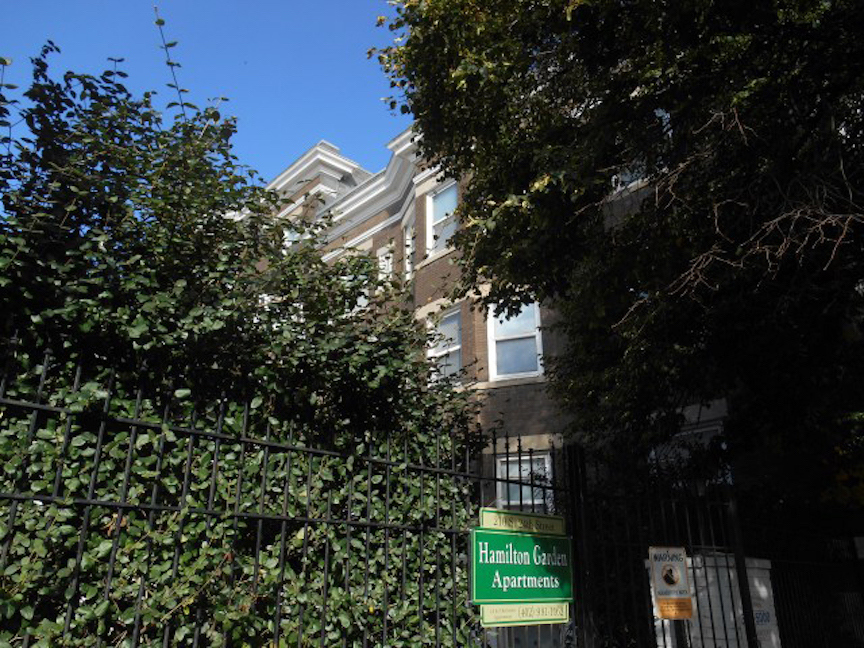
The apartments today as they look for 24th Street. Perfectly hidden from view.
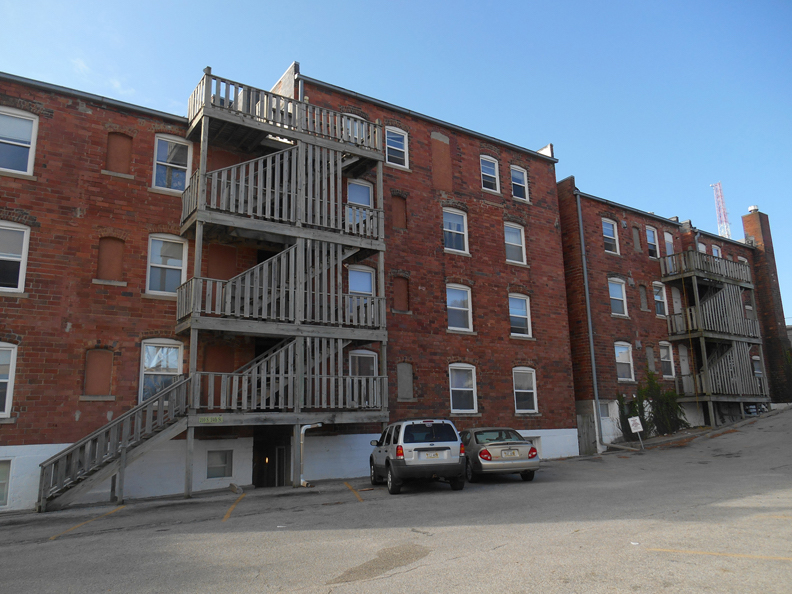
The backstairs of the Hamilton Apartments. A friend of ours in the punk scene of the late 80s lived in these apartments and we all spent a good amount of time trudging up and down these back steps–albeit, the stairs were considerably more rickety back then. This was also another good spot to watch the comings and goings of the downtown sexworkers. These highly visible stairs and large parking lot face Harney Street and are probably the only things most people have noticed of a trace of the Hamilton Hotel Apartments any more. I, myself, never knew what it had been or why this large complex awkwardly faced its backside to a large, busy thoroughfare that is Douglas Street.
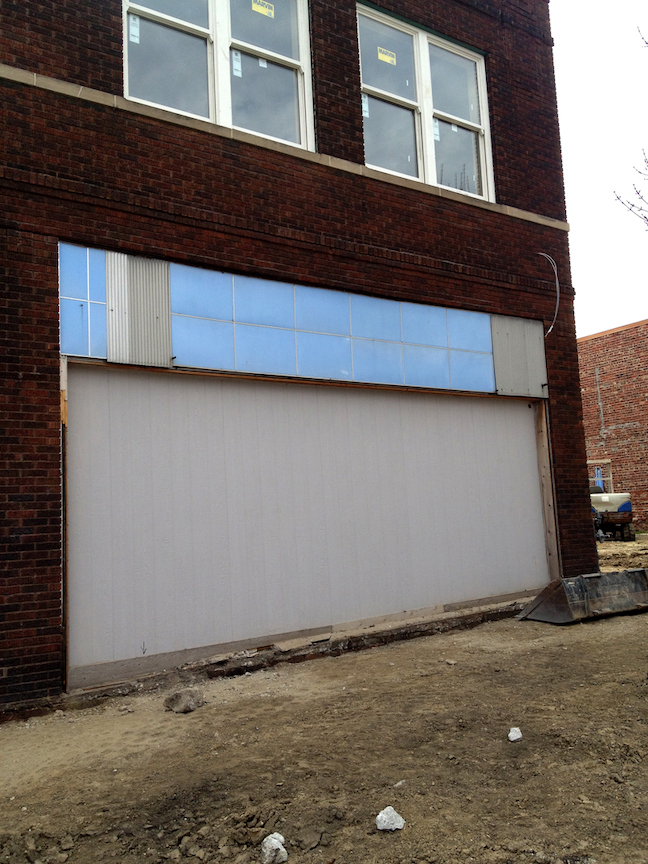
In the year 1915 the Fisk Rubber Company appears at 2403 Farnam. This bay was in, what is now called, the Junction Building. I had always heard of it as the Powers Building, as in the Powers Pharmacy. This photo was taken before they had renovated this building. I loved the blue tile and thought for sure they would keep it. Years later the 308 Bar holed up, facing 24th Street and the Boxing Club were above. (I suppose I will save this all for another story.) The new renovation features storefronts and apartments on ground level including apartments above. Check out http://www.thejunctionomaha.com/ for more details.
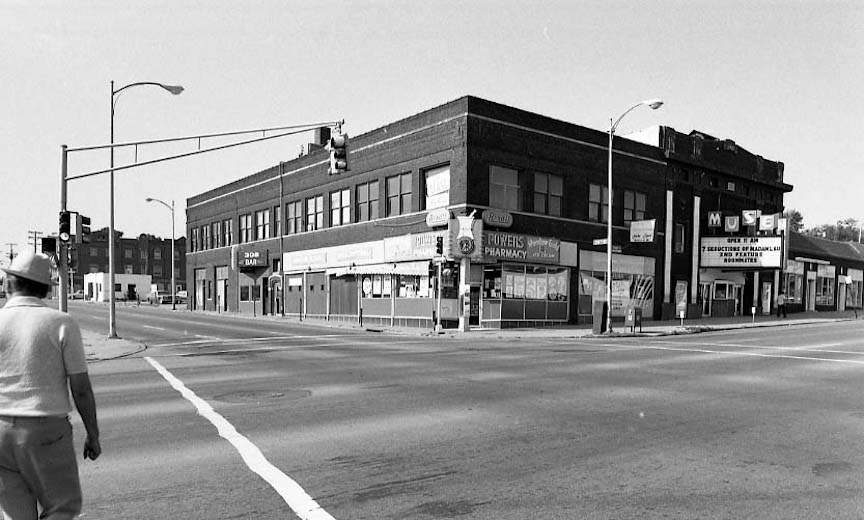
This great photograph from the 1980 Douglas County Reconnaissance Survey wonderfully captures the two buildings together. Seen to the far south is the 308 Bar. On the corner is the Powers Pharmacy. The Muse Theater is seen in the west.
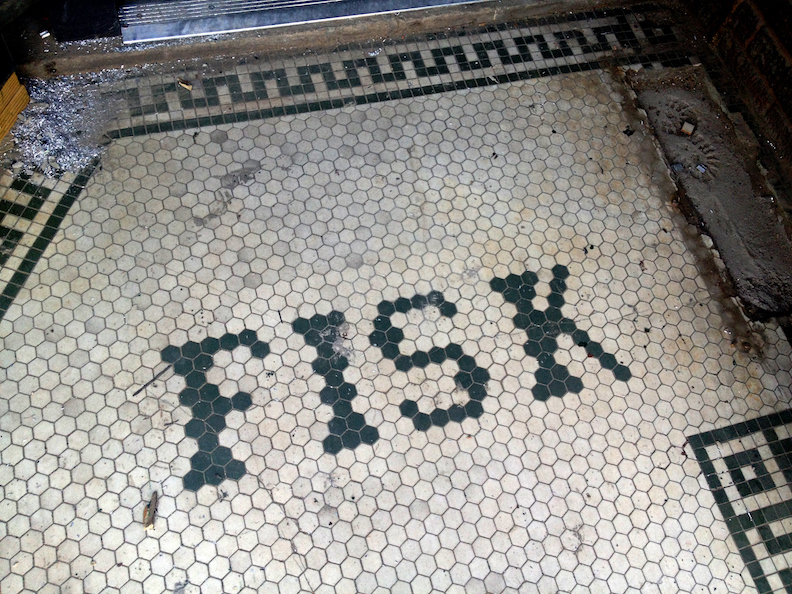
Fisk Rubber Company tiles A few years ago before the Powers Building was renovated I captured this shot. I didn’t know what Fisk was at that time. I’ve always loved this type of tiled, recessed store entryway with display windows on either side. Business owners frequently placed their name or the type of their business in letters to announce the threshold.

As it turns out, the Fisk Rubber Company was a very large franchise throughout the United States. This ad is from 1917.
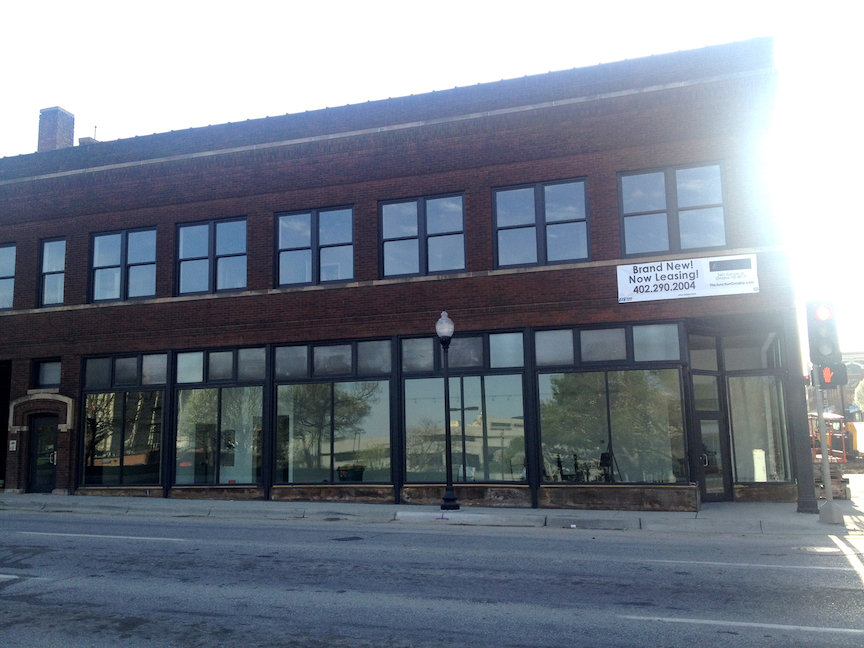
1916 brought Roger & Maches Confectionery to 2401 Farnam. Right on the southwest corner of 24th and Farnam, in what is now Look Portrait Studio. Check out their page at http://www.lookomaha.com/. As it turns out, the Look Portrait Studio is no longer in this location. The Grove Juicery has been here for years now. Thegrovejuicery.com/
I am assuming that Roger & Maches Confectionery was most likely peddling their own sweet recipes, but they possibly were in the medicinal preparation business also. These remedies were usually made with sugar, syrup, or honey also. Either way this corner enjoyed a long history of housing successful candy shops and pharmacists.
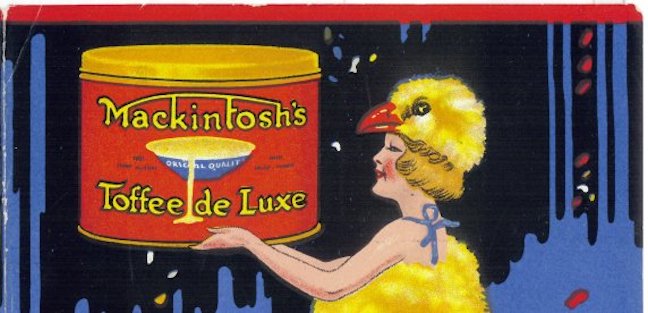
Designed by local architects, father and son team, John and Alan McDonald, the Muse Theater at 2405 Farnam Street, entered stage right in 1916 as a vaudeville and movie house. The McDonalds are known for their astounding architectural contributions to Omaha– the First Unitarian Church, Joslyn Art Museum, the Faidley Building (now demolished), George Joslyn House (Joslyn Castle), Beth El Synagogue, Bradford-Pettis House and the Hill Hotel, to name a few. To put a finer point on it, the Muse Theater was off to an auspicious start. These blueprints and architects’ drawings are dated, June 28, 1916, even though first showings in the theater were announced in April of 1916.
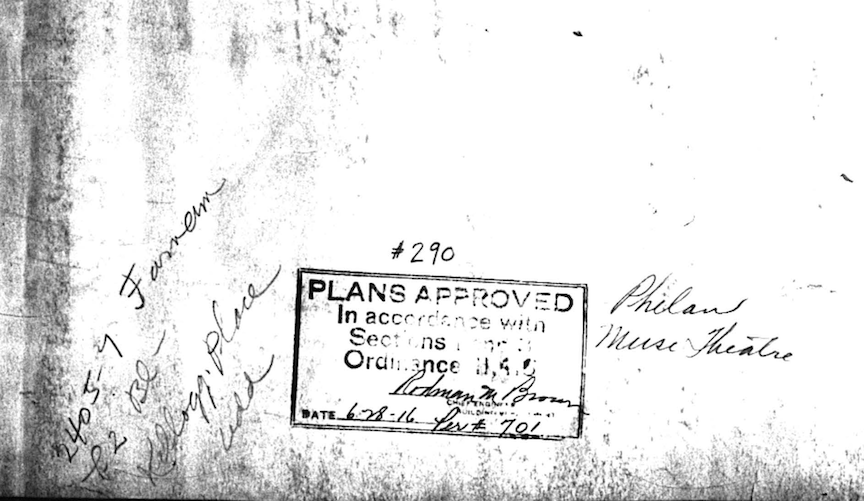
They are labeled “Motion Picture Theatre for Phelan and Shirley. 2405-2407 Farnam. John McDonald, Architect.” I could see from the Register of Deeds that Edward Phelan bought the land on April 20, 1914. The Muse had one screen and 850 seats. The front elevation rendering is quite beautiful. Thank you to Joe Knapp, of the Omaha City Planning Department for getting me Muse Building Permit Plans from microfilm. I treasure these.

Front elevation. Just one of John McDonald’s many elaborate renderings for the Muse Theater.

First photo of the Muse in the newspaper.
The earliest mention of the Muse Theater was this full-page announcement in the Omaha World-Herald on April 14, 1916. I love the listing of local advertisers laying claim to their part in this incredible new building—listed below. I would sure like to have seen that McDonald designed concession stand.
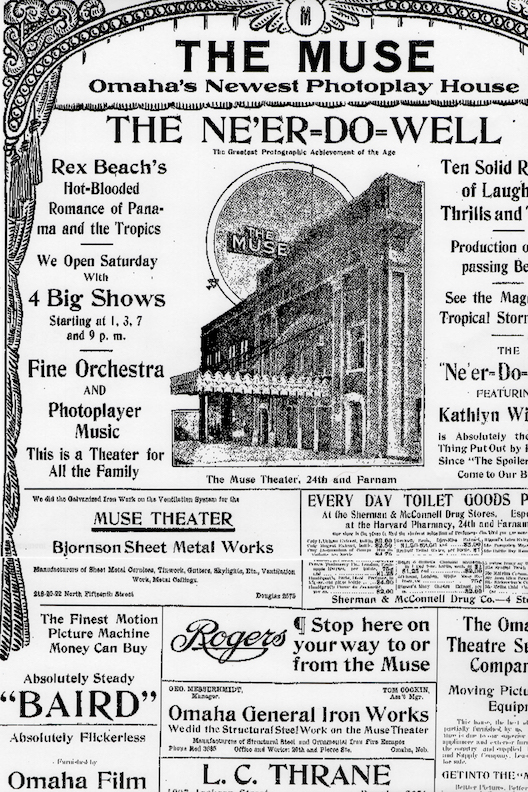
The Muse Omaha’s Newest Photoplay House. Opening with the “Ne’er Do Well,” Rex Beach’s Hot Blooded Romance of Panorama and the Tropics!!

My friend Bruce Karlquist sent this over this morning! The original movie poster for Rex Beach’s book and film, “The Ne’er-Do-Well.”
The Muse Theater was linked, early on, to two stories with a darker edge. In January 6, 1917, there was a highly publicized suicide of Edward L. Dodder, prominent Omaha undertaker and grand treasurer of the Nebraska Ancient Order of United Workmen. Doddler and his wife had apparently taken in a movie at the Muse Theater after he had attended a meeting of the Nebraska Workmen. Doddler then returned home to briefly say goodbye to his children and got his thirty-eight-caliber revolver. He left his watch, diamond ring, stud and all pocket money in a safe at his business and then drove “directly to his lonely trysting place with death,” seven miles north of Florence.
In February of 1919 the headline read, “Omaha School Boy Writes Home Folk About Own Death.” As the story goes, George T. Burns, a fifteen year old, ran away from his Omaha to the Hotel Jefferson in St. Louis. For reasons unknown the colorful OWH article laid out young Burns’s plan. He wrote letters both to the publisher of the OWH and his own family outlining how he was found dead in the St. Louis Hotel. He wrote under the name of the hotel manager. In said letter, which is very well written by the way, he admits to his great popularity, his versatile talents, his mysteriously beautiful fiancé and how he has managed the Muse Theater for years. It was asked the letter be published in the paper “for the benefit of his friends in Omaha.” The young Burns’ family received the letter and immediately sent the police to get their boy, who was safe and sound. For the record, the Muse Theater denied even knowing the boy.
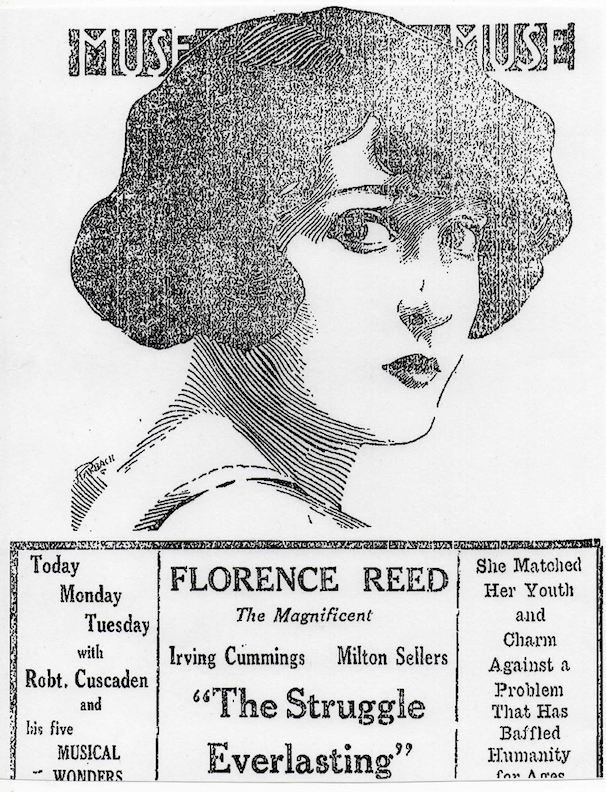
I love, love, love this early art deco ad for the Muse Theater. I adore the font and the simple illustration. “A problem that has baffled humanity for ages.” You know how I love my advertisements.
I discovered in my research that by 1917, further west along Farnam became a developing automobile showroom corridor. Here is a list of businesses west on Farnam.
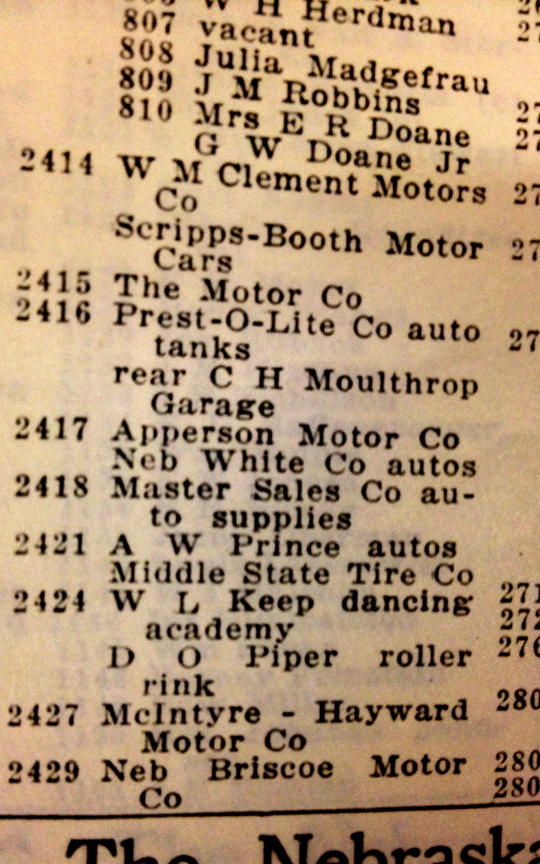
This automobile row would continue into the 1970s.
I found this fantastic ad from March 2, 1917. In it, there is an early “collabo” between the Muse Theater and Studebaker Wilson, Inc.

Studebaker is chosen. Prince Al Bene, the “Psychic Wonder of the World,” a Muse Theater traveling vaudeville performer was tasked with using his remarkable powers of mental discernment to find a mysterious hidden article. With use of the incredible Studebaker, he promised to find said article in 50 minutes. Nothing short of miraculous.
I continued to find mention of these vaudeville type acts. By February of 1918 Edward Phelan sold 2405 Farnam to Phelan Shirley Company. This was the name that John McDonald made his original drafts for. My investigations revealed that Robert D. Shirley was the other part of the company and was often listed as “owner” of the Muse Theater during this time period. I found evidence pointing to another of their operating names under World Realty Company. Harry Watts was the manager of the Muse. In a movie theater upset, Harry Watts resigned in April of 1919 to accept the management position at the Strand at Eighteenth and Douglas in Downtown Omaha. Side investigation into Harry Watts: The Writing’s on the Wall.
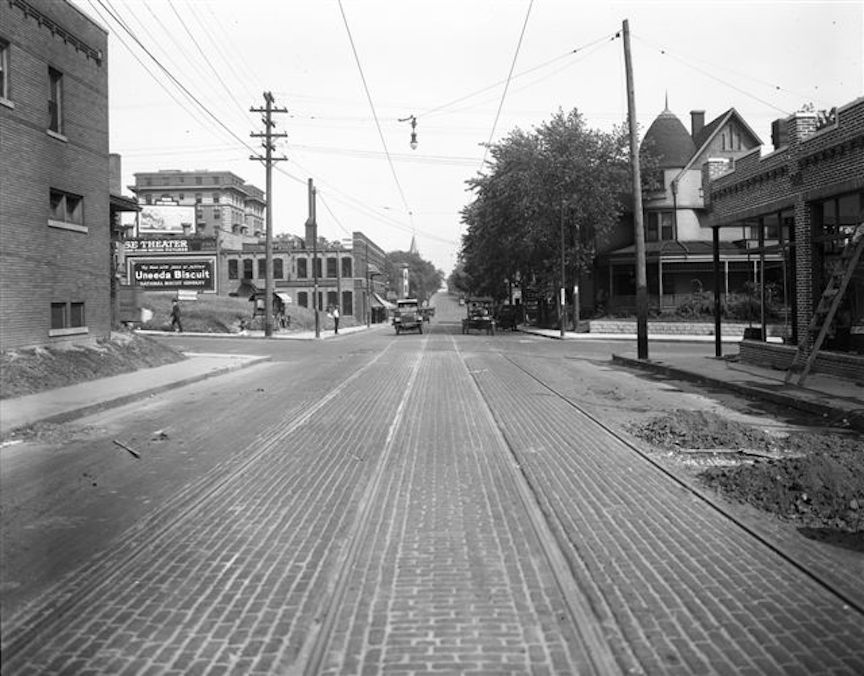
1919. Looking north on 24th Street from Harney Street. There is a large billboard for the Uneeda Biscuit Company on the corner. Directly behind that billboard is the Muse Theater on 24th and Farnam Street. In the background further still is the old Hamilton Hotel. Now this one gives a real feel for this part of town, the sound of the brick streets and how dense the blocks once were. (Photo courtesy of the Bostwick-Frohardt/KM3TV Photography Collection at The Durham Museum Photo Archive).
There was a bit of mystique hinted at when I stumbled across an article from August of 1919. New manager, Ballantyne, launched a new policy at the Muse Theater. “Better and fewer picture.” This pronouncement made known that the Muse “will buy only such pictures as are known to be of the higher class and each picture will be shown for a week.” This was the first theater house in Omaha to “adopt such a big-city policy.” I enjoyed the wording and sentiment. Class it up, Omaha. Meanwhile the article went on to expose that that week’s film, “Oh Boy” would feature “six attractive girls singing and dancing in and among the audience as well as upon a stage which has been specially constructed for the occasion.” Keep in mind, this was still considered entertainment for the whole family.
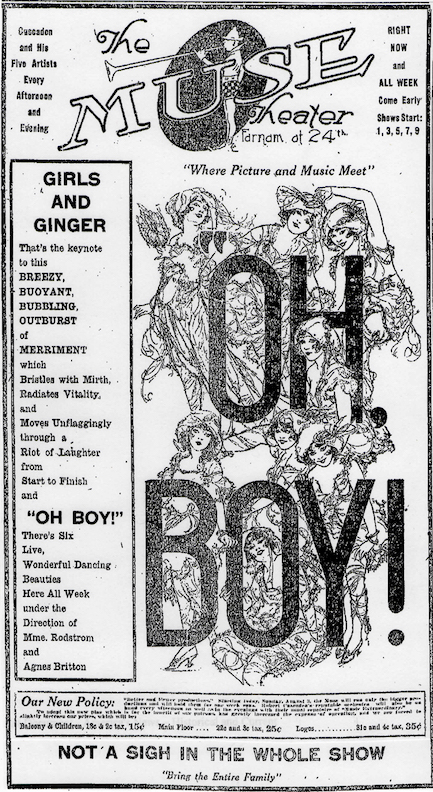
“Not a sigh in the whole show.” Amazing. I’m going to start quoting that. This illustration is sublime. It reminds so much of the books that my grandmother’s siblings had shared as children. As if the girls weren’t enough…that tall elf with a horn.

1919. Notice the Fisk Rubber Company one bay to the east. The Muse Theater using a lot of signage in those days. The marquee is quite substantial.

1920. Ruth Roland plays in “The Adventures of Ruth.” Beyond the marquee to the east, you can see that there was a prominent building across from 24th Street as well. It looks like a building is going in just to the west of the Muse Theater.
I found evidence that Roger & Maches Confectionery became just Roger’s Confectionery by 1921. This business expanded to include L. M. Roger’s Florist under the same address of 2401. Fisk Rubber Co remained at 2403 Farnam. The Towl-Bishop Company, a men’s furnishings store would move into 2404.
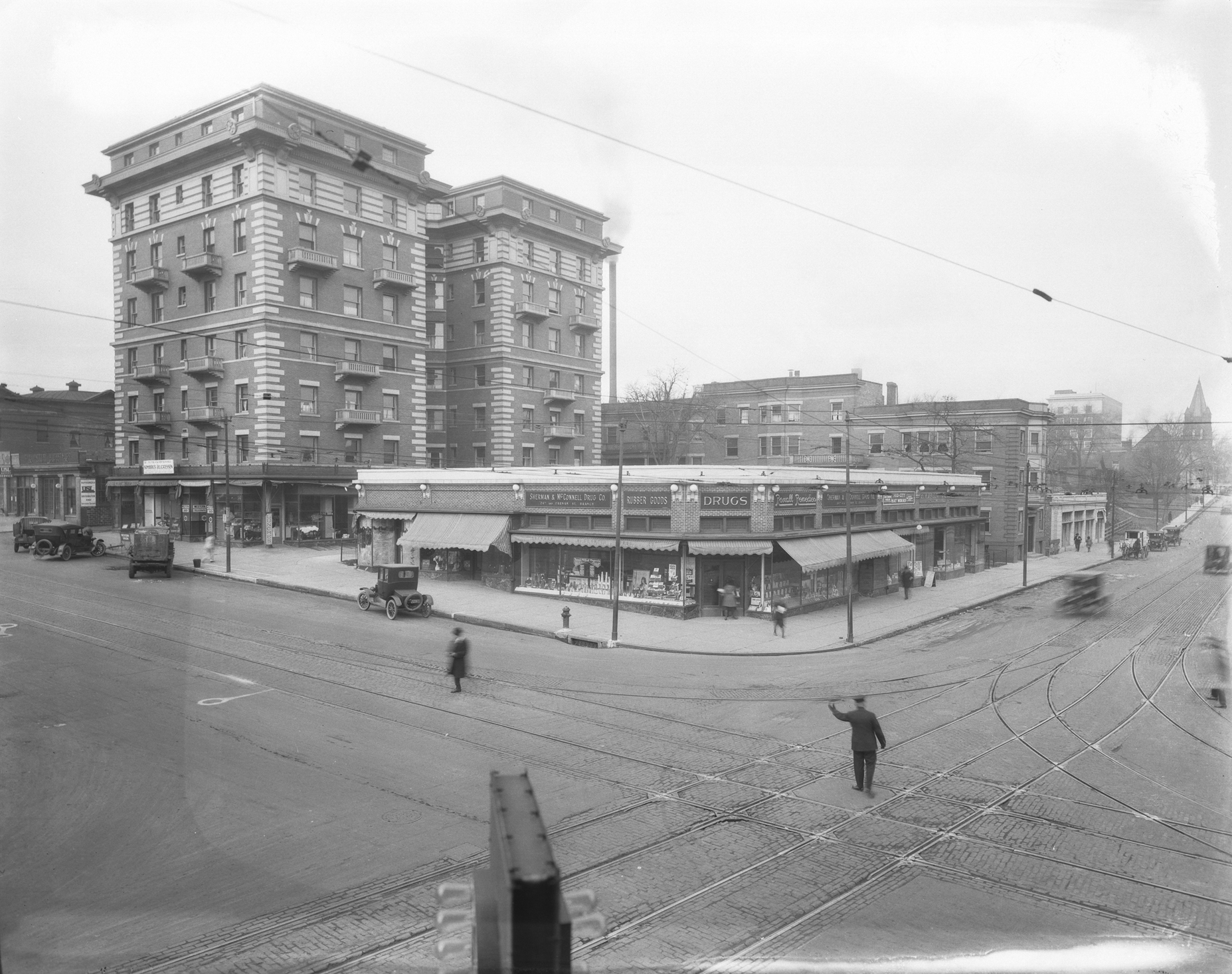
1920s. NW corner on 24th and Farnam. This gives a better idea of the one story retail corner that was put in place of the Hamilton Hotel Apartments courtyard. Also it illustrates, sans trees, the cramping that occurred with the shorter Hamilton Apartments butted up against this new construct. (Photo courtesy of the Bostwick-Frohardt/KM3TV Photography Collection at The Durham Museum Photo Archive).
By 1928 the one story of shops was fully operational and had taken reign of the once Hamilton Hotel courtyard. Liggett Company Drugs is at 2400 on the northwest corner of 24th and Farnam. Rogers Confectionery at 2401 then became the Goody Shop Confectioners. The Spic & Span Grocery Store is at 2403, previously Fisk Rubber Company. D. N. Hatt Meats was also housed within. 2402 was Harry Matsuo Photography Studio. 2406 was Cleo’s Beauty Shop. The Muse Theater is now considered 2407 Farnam. Hamilton Hotels’ address also shifts to 2410 from 2412-2414 Farnam.

8/13/1928. Looking west on Farnam Street from 24th Street. There are cars parked on the street and car traffic is on the street. A man stands next to a car in the street and behind him is a bicycle parked against a light post. Notable buildings include the Muse Theater, Hotel Hamilton, Saunders “Drive it Yourself” System and further up the road the new car showrooms. In the far distance you can see Kountze Memorial Church. (Photo courtesy of the Bostwick-Frohardt/KM3TV Photography Collection at The Durham Museum Photo Archive).

9/23/1933 Radio Station WAAW of the Omaha Grain Exchange party for kids at the Muse Theater. I can’t get enough of this one, especially when I think of what the world must have been like in 1933. (Photo courtesy of the Bostwick-Frohardt/KM3TV Photography Collection at The Durham Museum Photo Archive).
By May of 1934 Phelan Shirley Company sold the Muse Theater to Marie Matthews.

7/9/1934 Looking at the southwest corner of 24th & Farnam Street. There are people walking in the area and lots of cars. Two men are working in the middle of the intersection. There is a drugstore with large awnings next door to the Muse Theater. (Photo courtesy of the Bostwick-Frohardt/KM3TV Photography Collection at The Durham Museum Photo Archive).

My Omaha Obsession reader, Margaret from Aurora, CO had a brilliant clue: “When I looked up the movie Marked Woman with Bette Davis, Humphrey Bogart, and Allen Jenkins, it was actually 1937. I can’t really read the rest of the marquee except for maybe James Dunn, but that looks like a different movie.” The point being, this wonderful photo must have been taken in at least 1937. Thank you, Margaret!

5/26/1937. A group of people standing outside of the Muse Theater during the evening. There is a movie marquee for “We’re On the Jury” and “The Jungle Princess.” Customer: Motion Picture Association. This was the Muse Theater at its height. Can you get in and get a load of those outfits? The wool coats are to die for, as are the shoes. This photo is really incredible. This must have been a cold May evening. (Photo courtesy of the Bostwick-Frohardt/KM3TV Photography Collection at The Durham Museum Photo Archive).
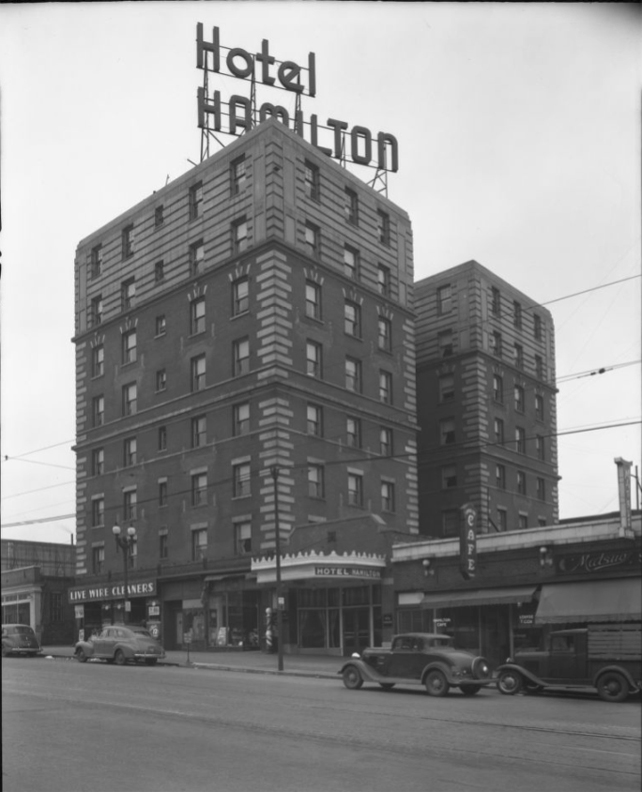
11/9/1941 Hotel Hamilton at 2402 Farnam Street. Later to became the Hamilton Apartments. Looking northwest from 24th and Farnam Street. Notice the Hamilton Café, the Matsou Studios, Liggett’s Drug Store. Further west is the Live Wire Cleaners. (Photo courtesy of the Bostwick-Frohardt/KM3TV Photography Collection at The Durham Museum Photo Archive).

The marquee didn’t just look heavy, it weighed several tons. Thankfully no one was injured. “Theater manager Harry Watts believes the cold crystalized the tie-rods that held the 20 x 20 canopy, causing them to break.” Photograph taken January 3, 1942. Notice Candyland, now next door. This was a very popular teen hang out, according to the incredible book, Born Rich by Margaret Patricia Killian. Candyland had every decadent candy a teen could desire back in the early 1940s. (Photo courtesy of the Omaha World Herald Collection).
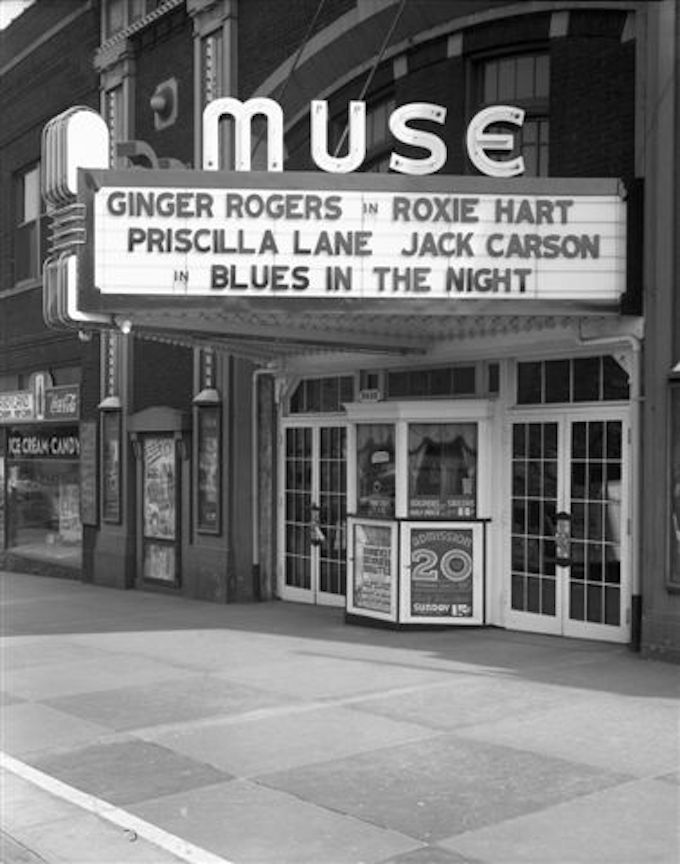
5/26/1942. A new, smaller, smarter marquee for a new decade. Above the box office is advertising a couple of movies with an admission price of 20 cents. 20 Cents? (Photo courtesy of the Bostwick-Frohardt/KM3TV Photography Collection at The Durham Museum Photo Archive).
Somewhere in this time period, you may have picked up, that Harry Watts returned to his management post of the Muse Theater. He is quoted in the OWH as the spokesman of the popular theater throughout this time period. I traced a great article from May of 1943 of Mr. Watts giving away films of all the big Nebraska University football games and Joe Louis prize fights from that year “…to the Army, Navy, Marine Corp, WAAC, SPARS or any other unit that wants these good movies, free of charge.”
By August of 1947 Marie Matthews, Muse Theater owner, signed a special warranty deed over to the Avon Theater Corporation. Miss Cassette had to look this up, not knowing right off what a “S.W.D.” meant. This kind of real estate says the seller only warrants or guarantees the title against defects “in clear title that may have arisen during the period of its tenure or ownership of the property.” This is considered a lower quality deed.
In 1952 the Muse Theater had a new manager, Jack Gelfand. Gelfand, actually misspelled as “Gilfand,” made the paper due to an unfortunate matter. Gelfand had to kick a row kid out of the theater on a Saturday night. Three male friends and two girls joined the indignant youth outside. “Then the youth proceeded to kick out a 40 by 60 inch display window,” Mr. Gelfand reported to the police.
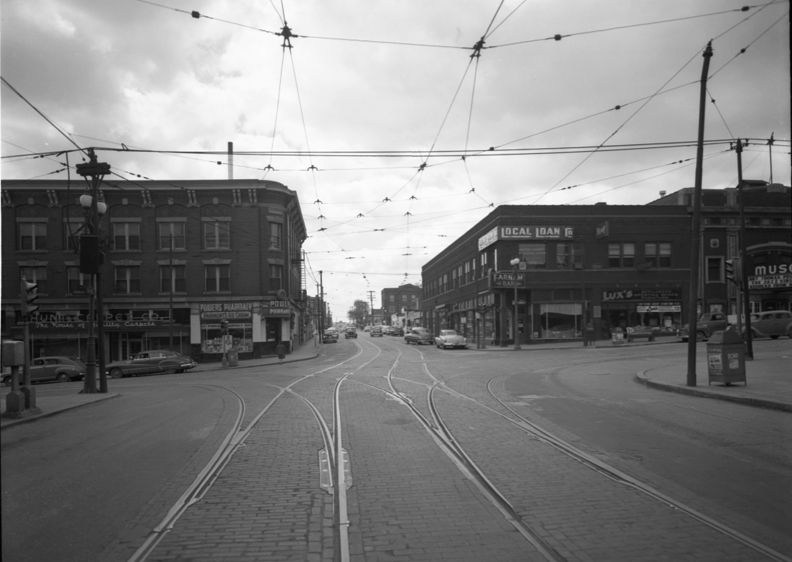
4/26/1953 Looking south on 24th Street from Farnam Street at the streetcar tracks. The Powers Pharmacy is on the left and the Farnam Bar and the Muse Theater are on the right of the intersection. Look at those street car webbings in the sky. How ominous and bizarre.

1953 detail. Notice the Farnam Bar now on the corner and Lux’s Appliance, Sporting Good and Furniture Store. The Local Loan Company is upstairs. Quite a different block.
Part Two
I began to find pieces of evidence in the 1957-1958 time period that led me to believe the Muse Theater was leaning toward the burlesque arts. Around that time period the Muse began to replace the Town Theater, at Fourteenth and Douglas, as Omaha’s burlesque theater. The Town closed due to continual arrests and seizings by the vice brigade. The Cooper Foundation acquired the Muse in 1958 when it bought up ten theater properties in Omaha and Council Bluffs from the estate of the late Ralph Goldberg. The Muse was then, apparently, leased out by the Cooper Foundation to Jack and Ruth Gelfand. I found all kinds of names on the lease at this time including Esther Hermione Goldberg (most likely Ralph’s wife), North Omaha Theaters, George De Lacy and Thomas R. Burke. The couple ran the theater for about twenty years on leases from both the Goldberg and Cooper interests, of which these names were all involved. Are you tracking this?
By December 8, 1961, theater owner, Mrs. “Betty” Gelfand (Jack Gelfand’s wife, Ruth) was arrested for showing the nudist feature, “Some Like It Cool.” According to one of our readers, Ryan Roenfeld, this film starred an Omaha gal! Not only was the “naturalistic, blushing color” film seized but the police took “Fire Under Her Skin” as well. This was the first time since the Town that a downtown movie house was raided, reportedly prompted by an unusual amount of complaints. “Following the raid, two comedy films were substituted and the show went on.”
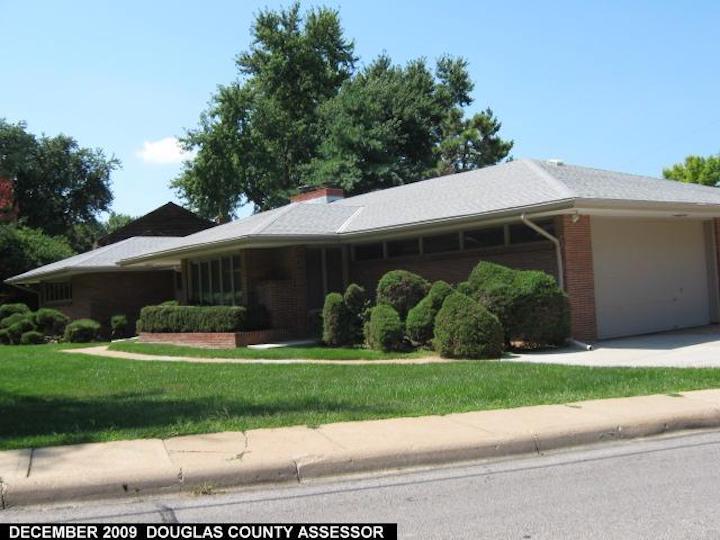
904 North 66th Street. The fabulous MCM 1957 ranch of the Jack and Betty Gelfand. I believe that Jacob “Jack” Gelfand died in 1959, leaving Betty to run the theater.
The Muse Theater was held up for about $200 in late December of 1961. Apparently a “bandit with a parka pulled tightly around his face” robbed Mrs. Rose Schwidelson, box office attendant, at gunpoint. The concession stand clerk, Percy E. Wylders walked into the lobby at the time of the robbery and was also ordered to sit on the floor. Neither was hurt.
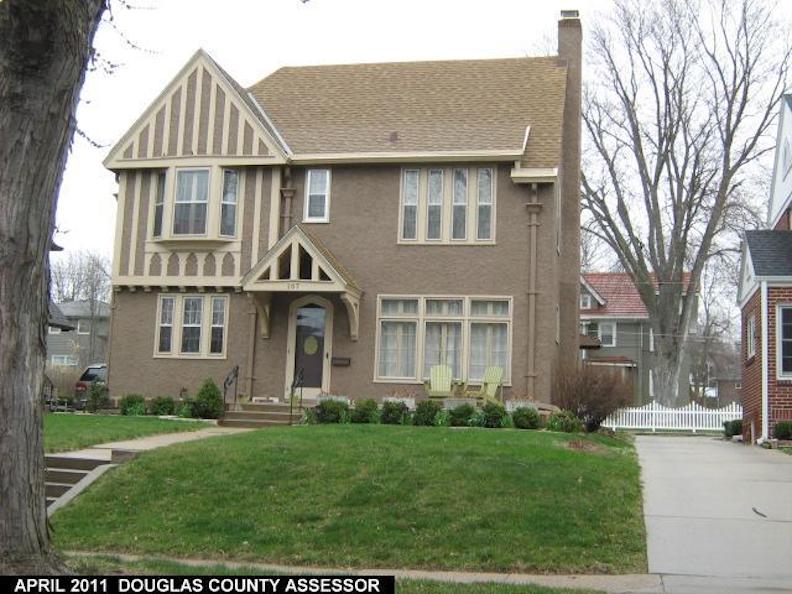
Get a gander at Mrs. Schwidelson’s gorgeous Dundee home at the time of the robbery. 107 South 54th Street. Storybook.
The Muse Theater was then sold to Mr. and Mrs. William Skolnik of 904 North 66th Street. The same MCM house. Actually our same Ruth Gelfand. William and Ruth married a number of years after Jack’s death. William “Bill” Skolnik, a World War II veteran, had been associated with Abe Slusky for 30 years in the operation of the old Krug Park in Omaha and the Playland Parks in Council Bluffs and Houston.

A postcard from the infamous Krug Park.
Bill and Ruth outright bought the Muse Theater in 1963 from the Cooper Foundation. They made note of their intentions to remodel the theater and plans to modify their motion picture bookings in the future. I believe this is when the marquee and sign changed again to the happy, playful, Disney-like font that I so loved as a child.
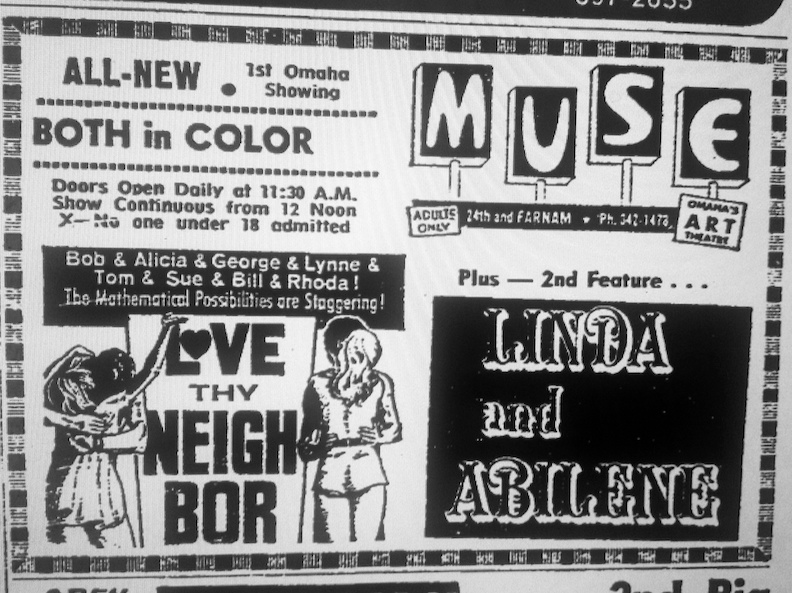
October 26, 1970. The Muse Theater ad. This was but a little taste of what the Skolniks had in mind with their new policy. Those are the letters of the marquee that I remember so well. “Omaha’s Art Theater.”
From that point on I found a whole dossier of newspaper articles, one after the other, on the Muse Theater. It would appear from the countless articles that an obscenity task force had been formed, not unlike the vice squad of the bootleggers’ era. The Muse Theater maintained that they were showing “Stag Films” and art house pictures. According to a Michael Kelly article of March 15, 1972, Omaha City Prosecutor, Gary Bucchino, filed charges of “publication of obscene material” against long familiar offenders: the Art 16 Theater (2411 Leavenworth), the Muse Theater, the Ak-Sar-Ben Bookstore (1417 Douglas) and the Pussycat Theater (1314-16 Douglas). Kelly noted that the sheriff’s deputies ordered copies of “Antigone” and “Potpourri” from the Muse and “Classified Sex” and “The Sex Play” from the Art 16. Additionally seven books were purchased from the Ak-Sar-Ben Bookstore and about five from the Pussycat. Do you remember these colorful enterprises in our fine town?
It would appear that our Muse Theater moved into X rated films in the late 70s and early 80s. After raids, which were continual, the theater would placate by showing “softer” versions of the seized films. An issue was made in 1983 when the OPD told the Muse ticket seller and projectionist that they could take films, even when the Skolniks were obviously not on the premises. In late August of 1983 the Skolniks, through their attorneys, filed a lawsuit asking that a judge pre-screen two films to determine whether they were obscene. In a humorous move, not lost on anyone paying attention, the couple’s attorney then suggested “He may ask judges to pre-screen every film to be shown at the theater.” The Skolniks were in and out of jail and courtrooms during this time period.
In another witty article of 1983 by David Krajicek, the journalist poked some fun at Judge Francis J. Kneifl. “Lest his relatives and peers in Dakota city fear that the good judge has gone astray in the big city, let it be known that when District Federal Judge Francis J. Kneifl steps into the X-Rated Muse Theater this morning, it will be strictly in the line of duty.” The judge agreed to be the obscenity judge and was expected to view at least portions of six movies on that day. The Skolniks volunteered to show the movies to Kneifl at the Muse Theater. By November of 1984 the Nebraska Supreme Court ruled the Omaha Police Department had violated the constitutional rights of the Muse Theater owners when they seized the two films used to charge the Skolniks with distributing obscene material.
According to the police, they began to track the opening of the films. “We had information in the complaint that the theater was receiving just one version of their films. We heard that the first showing on Wednesdays (the day the movies change) was uncut, and then the cuts would be made to get the film to conform to the law.” Dunning then said, “They were making the cuts when we returned.” The article went on to questions, “What happened to the 20 people viewing the films when officers arrived, who kept seeing a different film appear on the screen? They just sat there and waiting for the next movie to start,” Dunning said. “They acted like it was intermission time or something.”
**Addendum of September 1, 2021. A My Omaha Obsession reader shared an interesting clue. There was actually an apartment built inside of the Muse and that the woman who ran the theater also lived there. At least the reader believed it was the owner. The reader became privy to this information when the owner woman put her up in a room for a while when she was in need. Was this thoughtful woman Mrs. Ruth Skolnik?
Part Three
The curtain came down on the Muse Theater in late 1984. A sad little grouping of black letters spelled out “For Sale” on the marquee. Reportedly the Skolniks were firmly asking $100,000 cash. Omaha City Prosecutor, Gary Bucchino had announced it was an “Omaha clean out.” Having led the movement to drive out pornography in the early 1970s, Bucchino successfully announced by 1985 “There are no more adult bookstores, peep shows or adult movie theaters operating in the city.” By this time Council Bluffs offered three adult bookstores, a bar featuring go-go dancers and an adult entertainment center advertising hot tubs, saunas and escort services: The Crest Theater at 547 West Broadway, Mickey’s Razzle Dazzle Go-Go Club at 3339 West Broadway, the Off-Broadway Adult Emporium at 3218 First Avenue and the occasional Applause Video store bust at 2715 E Highway 6 kept things lively in Iowa where the laws were more liberal than Omaha.

By January of 1987 Stuart Bullington, executive director of Farnam Arts, Inc, began making headlines in his attempt to rejuvenate the Muse Theater. He actively began a campaign involving the Henry Fonda family, in hopes of running a retrospective of Fonda’s film career. This was an attempt to clean up the Muse’s image by focusing on the Omaha native. The Farnam Arts group was struggling to come up with the Skolnik’s asking price. Their vision was to renovate the Powers Pharmacy building to the east and the building to the west would be converted into a restaurant with an outdoor café. “The three buildings would then be connected.” Bullington was, coincidentally, the Park East neighborhood executive director of Park East Inc. He speculated the acquisition and renovation of the theater, the restaurant building and the creation of a parking lot (which he wanted to create by razing the Hamilton Hotel) would cost $1 million. By acquiring only the Muse Theater, limiting the renovation, with a smaller parking lot, the cost would have been $295,000.
Bullington was “riding sky-high” in April 1987 with a more formulated plan of recreating the Muse Theater into an arts center, focused on films, theater, dance and concerts. The hope was to reopen in July of 1987. Even though the Skolnik’s price had now fallen to $75,000, team Farnam Arts Inc had only raised $5,100. The Peter Kiewit Foundation had turned down the group’s request for a $140,000 grant to renovate the historical theater. The Muse Theater continued to stand empty. Interestingly, it was during this time period that the Omaha Landmarks group stepped up to save the Astro Theater at 20th and Farnam. This would later become the Rose Blumkin Theater.
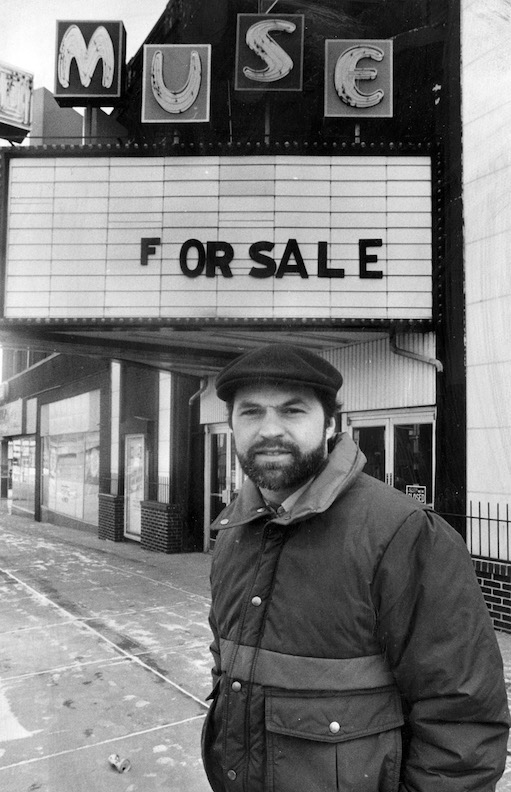
This photo was somehow mislabeled by the OWH. Burlington is Stuart Bullington and he never owned the Muse. Bullington, representing Farnam Arts Inc. wanted to buy it and save it. He gave it a good fight but his group was not able to raise the funds. This photograph ran in the Omaha World-Herald on January 18, 1987. Photo by Rudy Smith.
In August of 1988 a fire, causing $10,000 in damage to the interior of the vacant Muse Theater made the news. Days later the cause of the fire had not been determined and the Fire Chief was looking at arson as an option. Apparently the stage is what was burned. “The police records show that someone broke into the building, took a couple of antiques and, on their way out, poured gasoline on the stage.” Hmmmmm…?
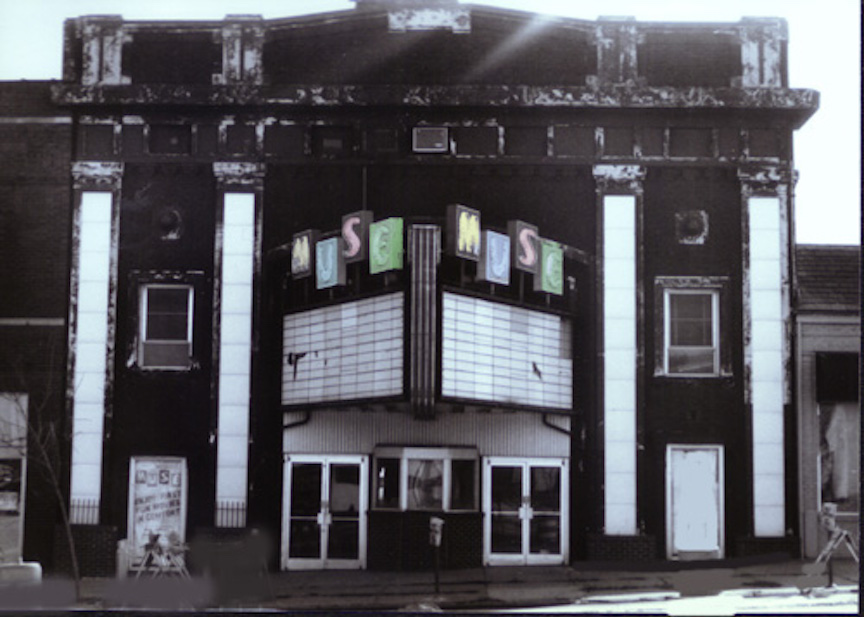
The late 1980s. Incredible photo by Rich Jeffrey. Is that an air conditioning unit up top? Is it true the Muse Theater was used as a haunted house for a season and that is why it was painted black?
Shockingly, a September 1988 article announced that a “private buyer” had purchased the Muse Theater. The marquee sign had last read the theater was up for grabs at the reduced price of $59,000 due to the burning of the stage. The damage was minimal with the seats, projector and concessions fully intact. Rumors flew around town that Dennis Moran, owner of the Dundee Theater at 50th and Dodge, had bought the place. It was true, he had looked into buying it. But he did not make an offer. By the way, the Dundee Theater was yet another John and Alan McDonald architectural design.
Mysteriously a spokesperson for the trust, USA Enterprises, came forward and began giving interviews. Mason Rad reported that he represented and was one of a group of Omaha investors who made up USA Enterprises. The group hoped to reopen the Muse in the summer of 1989. Rad expected their roster of shows to involve ballets, plays, comedy shows and possibly movies. Soon after a release was made announcing the Muse Theater had been sold for merely $35,000. A McDonald goldmine for $35,000? Unbelievable. I am still in shock as I type this.
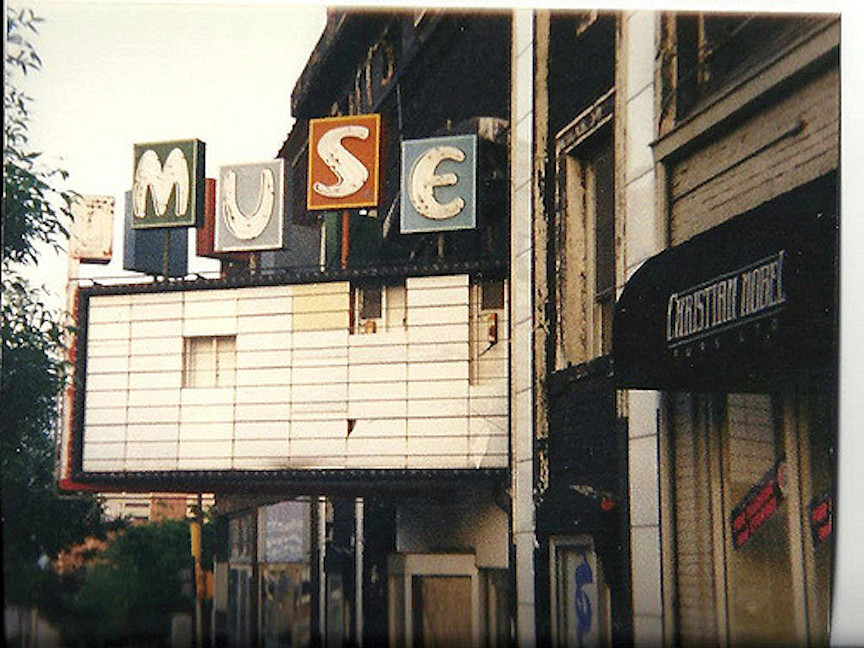
In the last days of 1995. This marvelous document was captured by Admiral 58 on Flickr. I have made every attempt to contact this photographer through Flickr. Lord knows there are a whole lot of phone messages left on some poor, unsuspecting fella’s voice mail in Omaha when I thought I had discovered his true identity. If anyone knows how to get a hold of the real Admiral 58, please let me know. I really love this one. Notice the Christian Nobel Furs shop next door. This is very posh store which has understandably relocated to West O. Judging from the red signs in the window, it had a moving sale of some type.
As mysteriously as he appeared, Mason Rad disappeared. Surprisingly nothing happened at the Muse Theater. There was no “summer opening of 1989.” There was actually not even a peep in the paper. It came and went. By November of 1998 there was a three-alarm fire called to the vacant theater. This time the fire began in the ticket and concession area, spreading to the third floor attic and to the back of the building. Arson was expected. Damage was estimated at $100,000. The Muse Theater was officially destroyed. Mason Rad, then named the sole owner of the theater, said he had planned to turn the theater into a Christian theater and church. What? I was getting confused. “Rad said he still hopes to rebuild but the building was uninsured. ‘We’ll let the Lord take care of it now,’” he was quoted as saying. I found the whole situation puzzling. One could assume that at $35,000 Rad had been acting alone all along when he bought the building. Maybe there really were other investors and they bailed out. Maybe he was a dreamer and hoped he could float the project in time. But the projections of Bullington and the Farnam Arts Inc group would lead one to guess that at a bare minimum $140 something was needed. I think it must have gotten away from Rad and he couldn’t make the dream happen.
***Addendum of August 30, 2021. My friend GeorgeAnne Catherine Prescott shared these perfect clues from the past: “I was in negotiation to buy The Muse when it burned down. My idea was to have a music venue, for original acts in any genre and I did want to live there. Upstairs in the projection room were reels going back decades (not the porn). Two reels I remember seeing were Gone With the Wind and Mary Poppins, but there were hundreds of them. I wish I would have taken pictures of the inside– especially of the projection room with its spacious apartment and balcony deck (above the marquee). The sound system was all Electro-voice and in full working order. Since the screen and projectors were all intact, I had hoped to thread the legal needles to have some movie nights as well. I was heartbroken at the loss.”
As if any of us can bear to hear about the final days… We’ve got to face this and I’m telling you, the story doesn’t get any prettier. By April of 1999, the Omaha City Council was arguing about where the demolition company could take the remnants of the Muse Theater. The Anderson Excavating and Wrecking Company had won the bid. Mason Rad, whose real name was revealed as Mohsen Niroomand, sued the city over its plan to demolish the closed theater. Rad argued that the city sent a condemnation notice to him at an erroneous address. The city attorney patently denied these allegations. Then Rad failed to gain a temporary restraining order against the demolition. Rad’s attorney claimed they condemned the building for minor code violations such as broken glass, litter and weeds. At this point Rad let it be known that his intentions had been to rename the Muse Theater the Omaha Christian Theater and hold youth activities and other Christian programming. It was also revealed that Rad described himself as a general contractor. The last trail I could find was that Rad planned to take his case all the to the Federal courts in hopes of fighting what he saw as a bamboozling by the city. It was not to be. Anderson Excavating Company began taking down The Muse Theater in October of 1999. I cannot imagine the ache that Mason Rad and Stuart Bullington must have felt. Miss Cassette doesn’t feel all too happy about this either.

Currently 2405 Farnam is a gated parking lot.
I can’t help but feel a little longing for what might have been. I would like to think the historical Muse Theater could have found a community voice in this time period but I can’t be sure. Maybe it is best that I never did poke my nose into the Muse. In this way, I can always remember her from the backseat of my parents’ passing automobile, in full command of her colorful, enticing lights, with that marquee calling out to anyone. I can see the theater lights now, leading the way along Farnam Street and there, up in the distance is another circle of women in shining attire, just entering the Smoke Pit for a bit of solace.
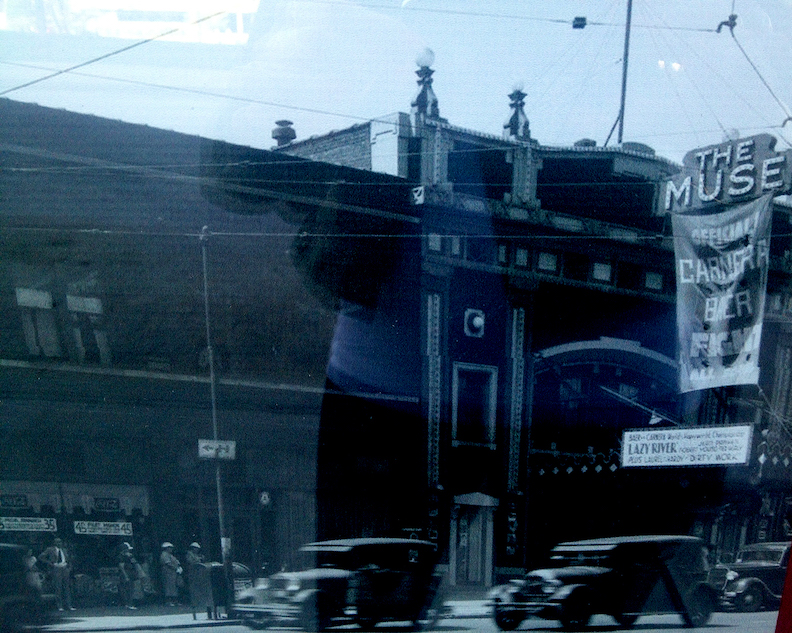
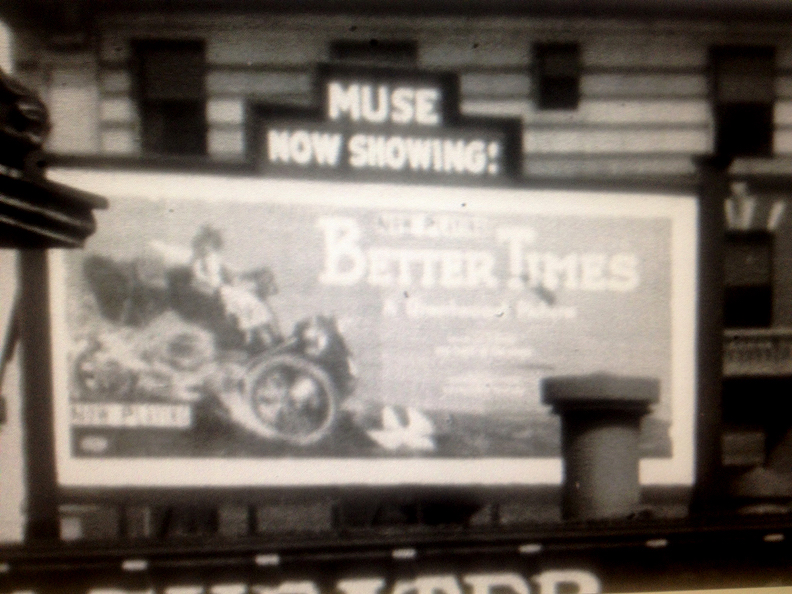
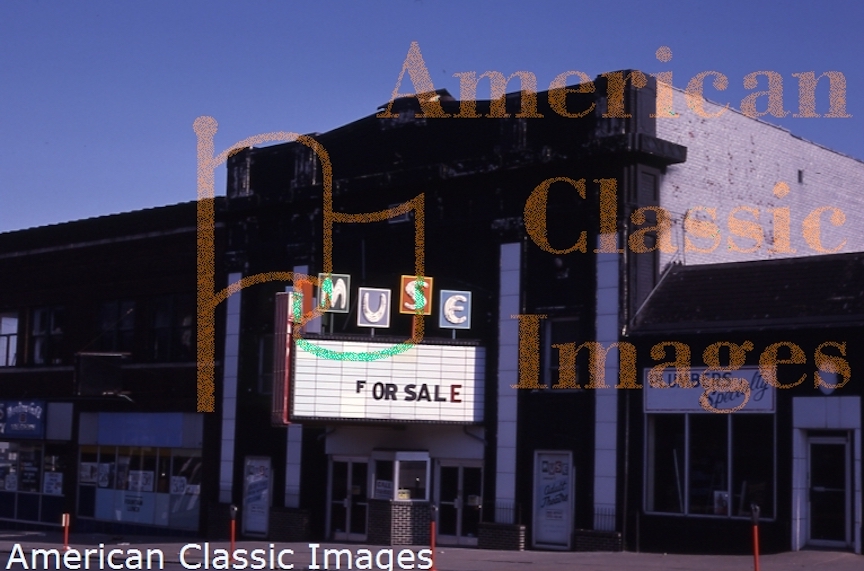
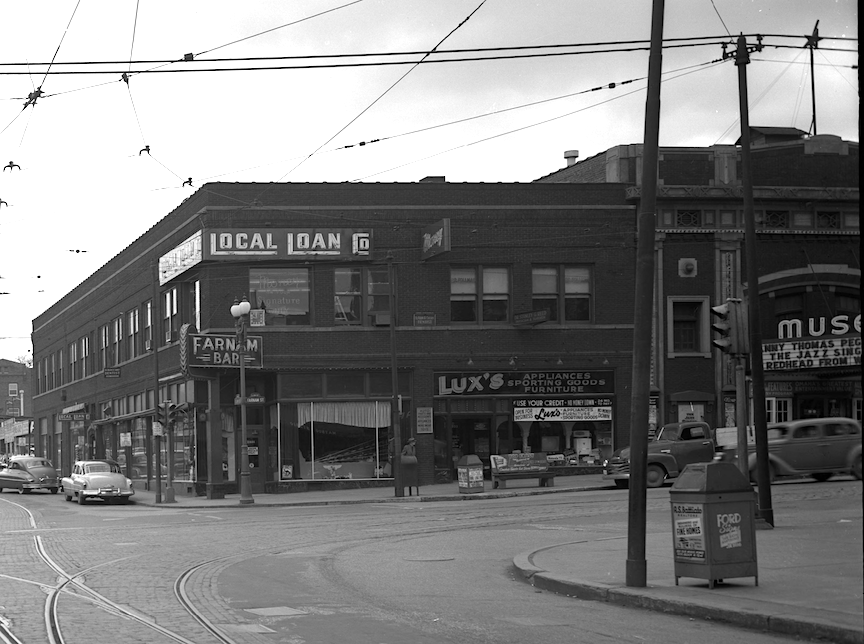
I welcome your feedback and comments on the Muse Theater, this time period and part of Omaha. To enable comments, please click on the header title. If you would like to correspond with me privately, please do so at myomahaobsession@yahoo.com. But I assure you, everyone would love to read what you have to say and it makes the conversation more fun. You can keep up with my latest investigations without even leaving your inbox, by “following” myomahaobsession.com. You will get sent email updates every time I have written a new story. Thank you Omaha friends.

© Miss Cassette and myomahaobsession, 2016. Unauthorized use and/or duplication of this material without express and written permission from this site’s author and/or owner is strictly prohibited. Excerpts and links may be used, provided that full and clear credit is given to Miss Cassette and myomahaobsession with appropriate and specific direction to the original content.
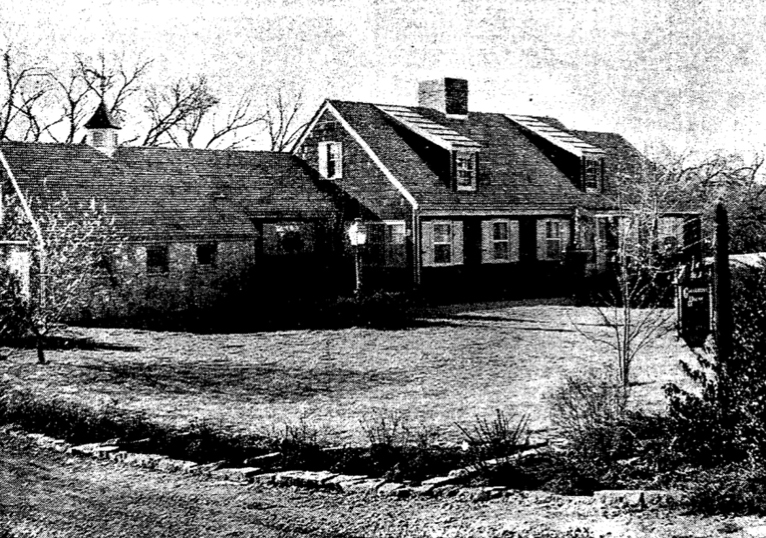

Oh BLESS You for taking me down memory lane, I grew up on 22nd Leavenworth but my stomping grounds was Jones- Harney-Farnam,. I remember so well going to those thrift stores on 24th that you spoke of in your article, again Bless You for such beautiful childhood memories. Sincerely Donna Fullerton
Thank you, Donna! Please stop by again and again.
I just discovered your online postings concerning Omaha NE.
My great grandfather was Michael Shirley, b 1850 in March Corners Ontario.
He moved to Omaha NE about 1890, and was a railroad and road Contractor.
He was the builder in 1913 of the two story brick building at 2401 Farnam, called the Ottawa Block, and with his brother-in-law Edward Phelan built the Muse Movie Theater in 1914. 2 years ago that brick building was renovated. Robert D Shirley was Michael Shirley’s son and had his own construction co in the 2401 Faram building.
Also of interest to you, he built and owned the house at Burt and 38th Street here shown during the construction of St Cecilia in 1913. He had recently completed a 50 mile railroad in Alberta Canada, and at age 63 had become very successful.
His granddaughter Jane Shirley went to the Duchesne Academy graduating about 1932
My great great grandfather was Harry Watts. Thank you for this amazing article. If you have any other information on Harry Watts, please contact me!
Hello, I’m Rich Jeffrey – the photographer you were looking for in one of the images. I’m honored you found the photo worthy and you’re welcome to use it. I was inspired to take the picture of the sad dilapidated building knowing it’s storied history (which you’ve done an excellent job of documenting here). I do believe it was used as a Bob Kerrey campaign location some time just before the picture was taken.
Thank you so much, Rich! Love your work.
I sold popcorn and candy at the Muse in 1955 or 1956. I remember Jack and his wife…also Rose, who sold the tickets. I ate my evening meal at the Delmar Hotel. When I was much younger, 10 or so, I went to the Muse every Saturday matinee. Under 12 ticket was 9 cents! Saw a double feature plus the newsreel.
Thanks for the memories!
Another great story! Thankyou for filling in many details about my great Uncle Louis Nash. Also thanks for the previous story about Catherine B. Nash who was my Great Grandmother. Love to meet you some day but I know anonymity is the name of the game for you. Keep up the good work and sleuthing. CC
My dad, Don Begley, and his brothers Pat and Bill, leased space to the west of the Muse. This was in the late 50s and throughout most of the the 60s. The business was Andersen Fire Equipment, Co., Inc. My Uncle Bill would occasionally walk down to the Muse and return with popcorn. This was in the 60s and the Muse was showing adult films. I was scandalized.
The leased space was torn down for a new 25th Street that runs one-way south. Twenty-Fourth street then was converted from two-way to one-way north.
Francis J. Kneifel was a state district court judge; not a federal judge. He was based in Dakota County and I appeared before him once. The stories were that he notarized his own signature and got grief over it. The other story is not well remembered by me, but he was over in Iowa and pulled the “do you know who I am?” stunt with the Iowa cops. I do know that he is one of the few judges to lose a retention election. He was a tyrant in the courtroom. Not well liked by voters!
I lived at the old “Rorick Apartments” So the thing that I did not appreciate was when the Smoke Pit would display a patriotic billboard it would end up getting vandalized.